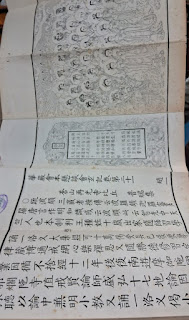Unveiling the Treasures: Exploring the Ancient Manuscripts Collections of Nava Nalanda Mahavihara, Nalanda
Introduction:
Nalanda, the ancient seat of learning in India, holds a rich legacy of knowledge and scholarship. Among its many treasures, the manuscripts collections at Nava Nalanda Mahavihara stand out as a testament to the intellectual vibrancy that once graced the region. In this blog, we delve into the fascinating world of the original ancient manuscripts housed at Nava Nalanda Mahavihara, uncovering the historical significance and cultural wealth embedded in these ancient texts.
Nava Nalanda Mahavihara:
Nava Nalanda Mahavihara, located near the ruins of the historic Nava Nalanda Mahavihara in Bihar, India, was established in 1951 as a center for higher studies in Pali and Buddhism. This modern institution strives to preserve and propagate the rich heritage of Buddhist philosophy, literature, and art. One of its most prized possessions is its extensive collection of ancient manuscripts that shed light on the intellectual pursuits of scholars who once walked the hallowed grounds of Nalanda.
Historical Significance:
The ancient manuscripts at Nava Nalanda Mahavihara span a wide range of topics, including philosophy, grammar, linguistics, medicine, and astronomy, among others. Many of these manuscripts are written in Pali and Sanskrit, reflecting the linguistic diversity of the texts that were studied and preserved at Nava Nalanda Mahavihara.
The historical significance of these manuscripts cannot be overstated. They provide a glimpse into the intellectual achievements of ancient India and the exchange of ideas that took place at Nalanda, which was a melting pot of diverse cultures and philosophies. The manuscripts also serve as a valuable resource for scholars and researchers seeking to understand the evolution of Buddhist thought and the broader intellectual landscape of the time.
Preservation Efforts:
Preserving ancient manuscripts is a delicate task that requires meticulous care and attention. Nava Nalanda Mahavihara has undertaken significant efforts to conserve and digitize its manuscripts, ensuring their accessibility for future generations. The digitization process not only helps in the preservation of fragile manuscripts but also facilitates scholarly research and collaboration on a global scale.
Exploring the Collections:
Nava Nalanda Mahavihara's manuscript compilation spans a wide spectrum of subjects, providing a valuable resource for researchers, historians, and enthusiasts. Among the noteworthy manuscripts are Buddhist scriptures, commentaries by distinguished scholars, treatises covering diverse knowledge domains, and rare palm-leaf manuscripts adorned with intricate artwork.
The collection extends beyond Pali and Sanskrit, reflecting the diverse cultural influences that converged at Nalanda Mahavihara. This linguistic variety adds depth to our understanding of the intellectual environment prevalent in ancient Nalanda. The library, curated by its founder Director Bhikkhu Kashyap, boasts a total of 560 manuscripts, excluding Tibetan Xylography, with some being exceptionally rare and precious.
Highlights of the collection include:
- 210 Sanskrit Manuscripts in Bengali and Devanagri scripts covering Sahitya, Vyakarana, Dharmashastra, Nyaya, Jyotish, and Karmakanda.
- 24 Assamese manuscripts focusing on Pali Tipitika and other Pali texts.
- A Pali Vyakarana manuscript on BANANA STEM in Ahmer script.
- A Sinhalese-scripted Palm-Leaf manuscript of Buddhaghosa's Visuddhimagga, addressing Sila, Samadhi, and Panna.
- Two Palm-Leaf manuscripts in old Burmese script, one of which dates back to the late 19th or early 20th century, featuring RED or GOLD lacquering and intricate decoration.
- Kammavaca volumes, one dating to the late 15th century, presenting extracts from the Theravadin Vinaya related to specific monk ceremonies.
- A Tibetan manuscript of Arya Asta Sahasrika Prajna Parmita Sutra from the late 15th century, adorned with opaque watercolors, gold-silver embossment, and depictions of Buddha Shakyamuni and Vajradhara.
- The collection encompasses Sanskrit Manuscripts, Assamese Manuscripts, various editions of Chinese Tripitaka, documentation of Tibetan Tripitaka, documentation of Sanskrit Manuscripts, and manuscripts and xylographs in Sanskrit, Pali, Assamese, Tibetan, Sinhalese, Burmese, Cambodian, and Chinese languages.
Conclusion:
The ancient manuscripts collections of Nava Nalanda Mahavihara stand as a bridge between the past and the present, connecting us to the intellectual legacy of Nava Nalanda Mahavihara. As we explore these manuscripts, we gain insights into the minds of scholars who, centuries ago, engaged in profound debates and discussions on subjects that continue to shape our understanding of the world. Nava Nalanda Mahavihara's commitment to preserving and disseminating this invaluable heritage ensures that the flame of knowledge ignited at Nalanda continues to burn brightly for generations to come.














Comments
Post a Comment